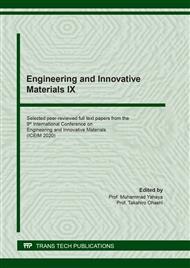p.17
p.23
p.29
p.35
p.43
p.49
p.57
p.63
p.71
Vacancy Formation Energy and Kinetic Properties of Liquid Metals
Abstract:
We investigated the relationship of the vacancy formation energy with kinematic viscosity and self-diffusion coefficient in liquid metals at the melting temperature. Formulas are obtained that relate experimental values of the vacancy formation energy, kinematic viscosity, and self-diffusion coefficient to the atomic size and mass, the melting and Debye temperatures. The viscosity and self-diffusion parameters are introduced. The ratio of these parameters to vacancy formation energy is equal to dimensionless constants. It is shown that the formulas for viscosity and self-diffusion differ only in dimensionless constants; the values of these constants are calculated. Linear regression analysis was carried out and formulas with the highest adjusted coefficient of determination were identified. The calculated values of the self-diffusion coefficient for a large number of liquid metals are presented.
Info:
Periodical:
Pages:
43-48
Citation:
Online since:
March 2021
Authors:
Price:
Сopyright:
© 2021 Trans Tech Publications Ltd. All Rights Reserved
Share:
Citation:


